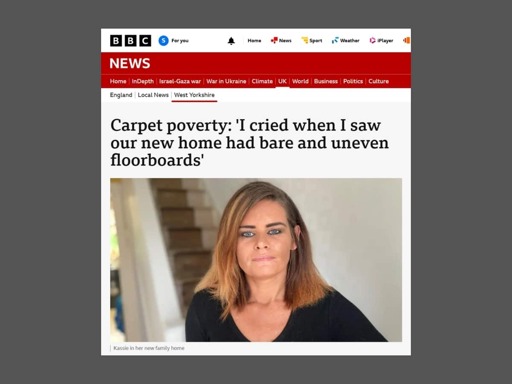The issues facing social housing in the UK right now could fill a library, never mind an extensive tag on the Canary website. From hundred-year waiting lists to [failing to meet](https://www.property118.com/thousands-of-social-housing-landlords-fail-decent-homes-standard-as-awaabs-law-looms/#%3A~%3Atext=The+Decent+Homes+Standard+(DHS%2Cto+the+private+rented+sector.) proper health standards, there’s plenty to pick from. However, the BBC has run an article titled:
Carpet poverty: ‘I cried when I saw our new home had bare floorboards’
This kind of framing is typical of the mainstream media. Plumping for a headline like “I cried when I saw our new home had bare floorboards” is, at best, ignorant of the heart of the issue. At worst, it’s setting the cause up for dismissal, especially by people who only read the headlines.
So, what is ‘carpet poverty’?
Carpet poverty
The actual article itself is slightly better than its flippant headline, mentioning the danger of exposed nails and splinters. However, there are plenty more reasons why unfinished floorboards in a property are a safety issue, not just an aesthetic issue or one of carpet poverty.
Campaign group End Furniture Poverty explained:
There are 1.2m people living without flooring in the UK and over 66% of them live in social housing.
Living without flooring is uncomfortable, and it can be dangerous for elderly people or those with disabilities because they are much more likely to hurt themselves if they fall. It makes life very difficult for families with young children if the home has concrete floors or dirty floorboards. The lack of flooring can create noise issues in flats and increase anti-social behaviour complaints and damage neighbourly relations. And it can mean homes feel and are colder without adequate flooring.
Many social landlords also rip out flooring when tenants move out, no matter what the quality, so the incoming tenant faces concrete floors, and even exposed grippers and nails.
Usually, people are moving into social housing precisely because they don’t have money to spare. Moving into any new house is a heavy financial burden in itself. Then, there are more important things to sort out immediately, like furniture and appliances. This can lead to a vicious circle where flooring is never at the top of the list of priorities. Especially, that is, when carpeting even a small house can cost upwards of £1,000.
The law doesn’t currently require the landlord to provide flooring anywhere other than the bathroom and kitchen. In social housing, it’s common practice for landlords to rip out the previous tenants’ flooring, on the grounds of hygiene. Conveniently, this also avoids liability for the state of the existing carpet. This, in turn, creates an environmental issue, as all of the flooring is sent to landfill each time social housing changes hands.
Decent Homes Standard
However, carpet poverty isn’t nearly the end of the issues facing people living in social housing right now. The BBC article also quoted a spokesperson for the ministry of housing saying:
it is wholly unacceptable for social housing providers not to meet the highest of standards.
That is why the government is introducing a reformed Decent Homes Standard so that all families have access to a safe home.
That ‘reformed Decent Homes Standard’ (DHS) refers to the outcomes of a currently-nebulous government consultation on socially and privately rented homes. It includes proposals for whole-property flooring requirements, along with security and energy efficiency minimums.
The reform consultation also included requirements for properties to be free of damp and mould, also known as Awaab’s law. It’s named for two-year-old Awaab Ishak, who died from a severe respiratory condition brought on by black mould in his social housing.
Awaab’s law
The details of Awaab’s law are more set-in-stone than the other outcomes of the consultation. Government guidance on Awaab’s law states that:
Awaab’s Law will come into force for the social rented sector from 27 October 2025. From this point social landlords will have to address all emergency hazards and all damp and mould hazards that present a significant risk of harm to tenants to fixed timeframes.
In 2026 we will extend regulations to include the following hazards where they present a significant risk of harm:
excess cold and excess heatfalls associated with baths etc., on level surfaces, on stairs and between levelsstructural collapse, and explosionsfire, and electrical hazardsdomestic and personal hygiene and food safety
In 2027, we will extend regulations to all remaining HHSRS hazards (apart from overcrowding) where they present a significant risk of harm.
Whilst these new requirements are all well and good, they’ll mean very little without proper enforcement. Unfortunately, rental industry research suggests that even the current version of the DHS is [barely being enforced](https://www.property118.com/thousands-of-social-housing-landlords-fail-decent-homes-standard-as-awaabs-law-looms/#%3A~%3Atext=The+Decent+Homes+Standard+(DHS%2Cto+the+private+rented+sector.):
According to Inventory Base, in 2013, more than ten years after the DHS was introduced, approximately 593,000 social homes still fell below the standard.
By 2023, that number had fallen by 27.8%, but these latest figures suggest around 428,000 social rented properties in England, more than 10% of the total stock, still failed to meet the required standard.
Inventory Base estimates that by the end of 2025, nearly 405,000 homes will still be classified as non-decent, almost a quarter of a century after the standard was first introduced.
Landlords cannot just be relied upon to treat their tenants with a basic level of human decency. They are financially incentivised to cut corners and leave properties in squalor. The potential reforms to the DHS – mould, heating and all – are good. However, they must be accompanied by actual consequences for the slumlords that fail to meet them.
Bare floors are just one facet of the litany of ways in which landlords are allowed to treat tenants as undeserving of a basic quality of life. We at the Canary are unsure where carpet poverty falls on the scale from bread to roses. But we’re damn sure that people in social housing deserve warm, safe, dry homes – and carpets too, while we’re at it.
Featured image via the Canary
From Canary via this RSS feed


